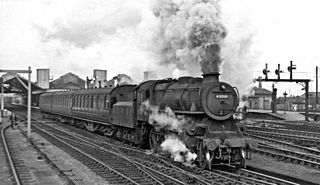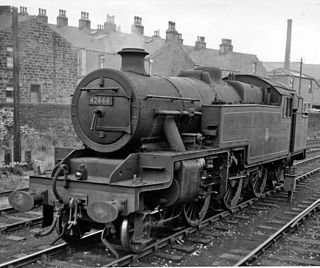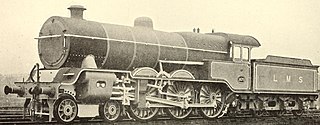The London, Midland and Scottish Railway had the largest stock of steam locomotives of any of the 'Big Four' Grouping, i.e. pre-Nationalisation railway companies in the UK. Despite early troubles arising from factions within the new company, the LMS went on to build some very successful designs; many lasted until the end of steam traction on British Railways in 1968. For an explanation of numbering and classification, see British Rail locomotive and multiple unit numbering and classification.

The London, Midland and Scottish Railway (LMS) Jubilee Class is a class of steam locomotive designed for main line passenger work. 191 locomotives were built between 1934 and 1936. They were built concurrently with the similar looking LMS Stanier Class 5 4-6-0. They were nicknamed Red Staniers and Jubs.
Sir Henry Fowler, was an English railway engineer, and was chief mechanical engineer of the Midland Railway and subsequently the London, Midland and Scottish Railway.
George Hughes was an English locomotive engineer, and chief mechanical engineer (CME) of the Lancashire and Yorkshire Railway (L&YR) and the London, Midland and Scottish Railway (LMS).

The British Railways Standard Class 5MT4-6-0 is one of the 12 BR standard classes of steam locomotive built by British Railways in the 1950s. It was essentially a development of the LMS Stanier Class 5 4-6-0. A total of 172 were built between 1951 and 1957.

The BR Standard Class 4 2-6-0 is a class of steam locomotive designed by Robert Riddles for British Railways (BR). 115 locomotives were built to this standard.

The Derby Works comprised a number of British manufacturing facilities designing and building locomotives and rolling stock in Derby, England. The first of these was a group of three maintenance sheds opened around 1840 behind Derby station. This developed into a manufacturing facility called the Midland Railway Locomotive Works, known locally as "the loco" and in 1873 manufacturing was split into locomotive and rolling stock manufacture, with rolling stock work transferred to a new facility, Derby Carriage & Wagon Works.

The London, Midland and Scottish Railway (LMS) Fairburn Tank 2-6-4T is a class of steam locomotive. They were designed by Charles E. Fairburn for the LMS. 277 of these locomotives were built between 1945 and 1951, numbered in the range 42050–42186, (4)2187–(4)2299, (4)2673–(4)2699.

The London, Midland and Scottish Railway (LMS) Stanier Class 5 4-6-0, commonly known as the Black Five, is a class of 4-6-0 steam locomotives. It was introduced by William Stanier and built between 1934 and 1951, of which 842 were built and were numbered 4658-5499. Several members of the class survived to the last day of steam on British Railways in 1968, and eighteen are preserved.

The London, Midland and Scottish Railway (LMS) Stanier Class 8F is a class of steam locomotives designed for hauling heavy freight. 852 were built between 1935 and 1946, as a freight version of William Stanier's successful Black Five, and the class saw extensive service overseas during and after the Second World War.

The London, Midland and Scottish Railway (LMS) Royal Scot Class is a class of 4-6-0 express passenger locomotive introduced in 1927. Originally having parallel boilers, all members were later rebuilt with tapered type 2A boilers, and were in effect two classes.

The London Midland and Scottish Railway (LMS) Stanier Class 5 2-6-0 or Stanier Mogul is a class of 2-6-0 mixed traffic steam locomotives. Forty were built between October 1933 and March 1934.

The LMS Ivatt Class 4 2-6-0 is a class of steam locomotive primarily designed for medium freight work but also widely used on secondary passenger services. The London, Midland and Scottish Railway (LMS) ordered 162 of this type between 1947 and 1952, but only three were built by the LMS before nationalisation in 1948. Designed by George Ivatt, they were classified 4F by the LMS and 4MT by British Railways (BR).

Sir William Stanier's London, Midland and Scottish Railway (LMS) Class 4P 2-Cylinder 2-6-4T was a class of 206 steam locomotive built between 1935 and 1943. They were based on his LMS 3-Cylinder 2-6-4T.

Horwich Works was a railway works built in 1886 by the Lancashire and Yorkshire Railway (LYR) in Horwich, near Bolton, in North West England when the company moved from its original works at Miles Platting, Manchester.

The London Midland and Scottish Railway (LMS) Fowler Class 4F is a class of 0-6-0 steam locomotive designed for medium freight work. They represent the ultimate development of Midland Railway's six coupled tender engines. Many trainspotters knew them as "Duck Sixes", a nickname derived from their wheel arrangement.

The LMS Stanier Class 4P 3-Cylinder 2-6-4T is a class of steam locomotives designed for work over the London, Tilbury and Southend Railway route. All 37 were built in 1934 at Derby Works and were numbered 2500–2536. The third cylinder was provided to allow increased acceleration between the many stops on the L.T.&S.R. line. From 1935 the LMS switched to constructing a very similar, albeit simpler, 2-cylinder design.

The Lancashire and Yorkshire Railway (L&YR) Class 8 was a four-cylinder 4-6-0 express passenger locomotive designed by George Hughes introduced in 1908.

The London, Midland and Scottish Railway (LMS) Rebuilt Royal Scot Class is a class of 4-6-0 steam locomotives. 70 members of this class were rebuilt by the LMS and its successor British Railways (BR) from LMS Royal Scot Class engines by the replacement of their life expired parallel boilers with a type 2A boiler over the period 1943–1955.. They were the second class to be rebuilt with type-2 boilers, after the rebuilding of British Legion and the Jubilee Class.
The L&YR 2-10-0 was a prospective design for a class of 2-10-0 steam locomotives on the Lancashire and Yorkshire Railway. Initial designs were made by George Hughes between 1913 and 1914, but none of the class were built. If they had been, these would have been the UK's first 10-coupled locomotives in regular service.




















